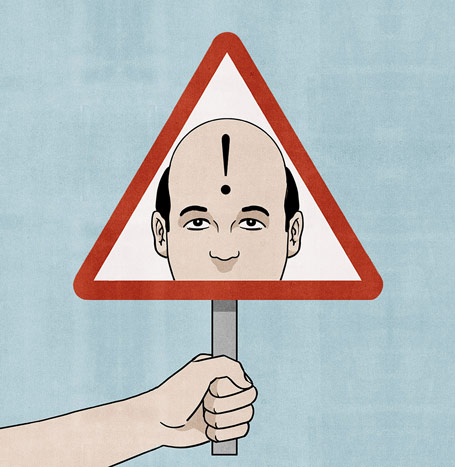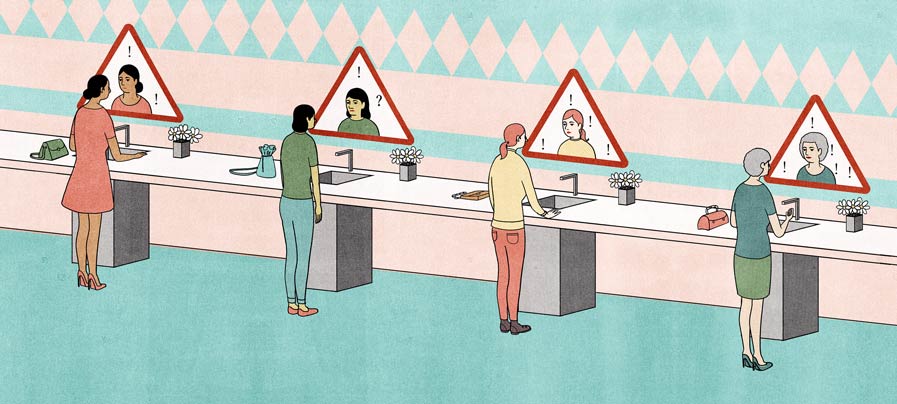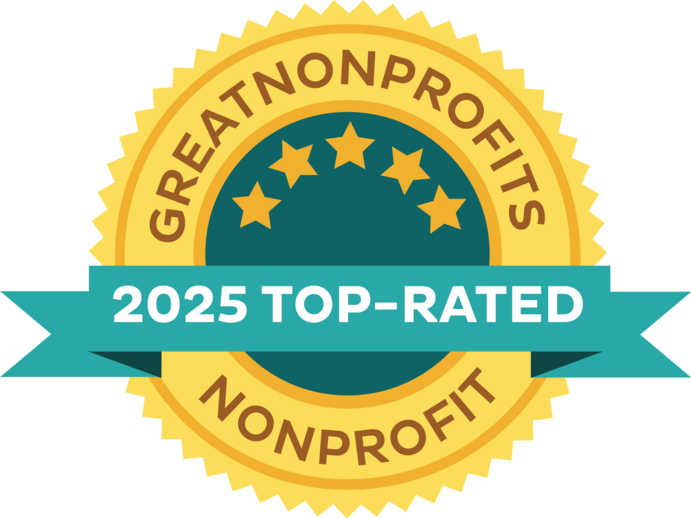Illustrations by SHOUT
If you (or someone you know) has been diagnosed with two or more nonmelanoma skin cancers, you are part of a special group. You are also, unfortunately, at much higher risk of developing further skin cancers. Here’s why — and what you can do about it.
In February 2017, Australian actor Hugh Jackman posted a photo of his bandaged nose on Instagram, saying “Another basal cell carcinoma.” This was one of many times he’d required surgery on his nose for this most common form of skin cancer. Imagine how that must feel when your face is shown on giant screens worldwide. Jackman told People magazine that he gets his skin checked every three months now because, “My doctor says I’ll likely have more.”
If you’re one of the millions of people who have been diagnosed for the first time with either a basal cell carcinoma or a squamous cell carcinoma (also called BCC and SCC, the major nonmelanoma types of skin cancer), you have better than even odds of getting another. About 60 percent of people who have had one skin cancer will be diagnosed with a second one within 10 years, says a 2015 study in JAMA Dermatology.
Your odds increase dramatically if you’ve been diagnosed with a second BCC or SCC (or third, or any other number beyond first). Then you have a 61.5 percent chance of being a repeat customer within just two years. So if you’ve been diagnosed twice, welcome to the high-risk club. Hugh Jackman is in it, and millions of regular folks like me.
Risky Business
“It’s important for patients to be aware of those statistics, because knowing they’re at higher risk can empower them to take action,” says New York City dermatologist Elizabeth K. Hale, MD, a senior vice president of The Skin Cancer Foundation. “While having previous skin cancers may be the greatest risk factor, knowing your other risk factors is also extremely important.” These include how often you’ve been sunburned, for example, and whether you’ve ever used tanning beds.
Many other factors can put you in this high-risk group, too, like your skin type, genetics and a family history of skin cancer, said Los Angeles dermatologist Ronald L. Moy, MD, former senior vice president of the Foundation. “Where did you grow up? How much Irish or English do you have in you? How much sun exposure have you gotten, and how much early exposure as a child?”
Some patients may think it’s no big deal to be diagnosed with a nonmelanoma skin cancer. For those whose BCC or SCC was detected early and treated right away, it usually isn’t a big deal. If they’re also among the 40 percent of people who won’t develop another skin cancer in the next decade, that’s great news. But for those of us who’ve had more than one, it’s important to understand that these skin cancers can be a big deal. While basal cell carcinomas almost never spread (metastasize), some can be aggressive, grow quite large and even become disfiguring. And squamous cell carcinomas can sometimes metastasize, spreading to lymph nodes or beyond if not treated early.

Watch Your Head! Men are less aware of the warning signs of skin cancer than women and less likely to use sunscreen. Let’s help change that!
Making matters worse, if you’ve had one type of skin cancer, statistics show you are also at risk for the other types, including melanoma, which can be life-threatening. The main reason for this risky situation? When your skin is exposed to ultraviolet (UV) rays from the sun or from tanning beds, it causes DNA damage in your skin cells. If repair processes in those cells don’t fix all this genetic damage, it can produce mutations that lead to skin cancer. If you’ve had multiple skin cancers, it may signal that you’ve had extensive sun damage, that your immune system is compromised, that your skin just doesn’t repair its DNA very well — or all the above.
“I see patients every day who have had multiple skin cancers,” Dr. Moy said. Some patients even get hundreds of them, such as a light-skinned commercial airline pilot from New Zealand he saw regularly. “When you’re on a plane, whether as a passenger, a crew member or a pilot, you’re bombarded with ultraviolet radiation. Some penetrates the windows, and even the fuselage doesn’t protect you completely.” Much DNA repair takes place at night, especially when you’re sleeping. So for those who travel a lot, lose sleep and get jet lag, that nighttime repair may be disrupted, putting them further at risk.
Make a Commitment
If you’ve had more than one skin cancer, it’s important to understand and accept that you’re at high risk. Then it’s time to make a lifelong commitment to prevention and early detection. “That is what makes skin cancer unique,” says Dr. Hale. “Patients can really take ownership. You can’t change your genetic predisposition, but there are plenty of things you can do.”
Detect Early
Finding a dermatologist you feel comfortable with who specializes in skin cancer (and accepts your insurance) is a good first step. Create a regular schedule for skin checks, and talk to the doctor about what to look for on your own skin and when to raise a red flag between regular checkups. For example, precancerous spots called actinic keratoses (AKs) can sometimes develop into SCCs, but you can avoid this by finding and treating them early. “It’s a matter of keeping up with these precancers and figuring out what we can do to decrease their chance of getting aggressive and progressing,” says Dr. Hale.
I see patients every day who have had multiple skin cancers,” said Ronald L. Moy, MD. “Some even get hundreds of them.”
Similarly, if you’re diagnosed with a BCC or SCC and need treatment such as surgery to remove it, it’s always better to do it when it’s small. “Sometimes a patient might say, ‘If it’s not going to kill me, why are you cutting into my face?’” Dr. Hale says. She explains that even though BCCs grow slowly, they may bleed, get scabby and unsightly, and invade deep into local tissue. Left untreated completely, they can eat through muscle, even bone, and that can make surgery more difficult and more disfiguring. SCCs can attach themselves to local lymph nodes and spread. “It’s much better to treat an SCC before it becomes a big problem,” says Dr. Hale.
Protect Consistently
First and foremost, Dr. Hale tells her patients to wear a broad-spectrum, high-SPF sunscreen every day, rain or shine, all year round. To help motivate people, she often cites three important studies that came out of Australia. For 20 years, the researchers followed adults who went from just recreational sunscreen use to everyday sunscreen use. They found that regular sunscreen use reduced squamous cell carcinoma by 40 percent and helped prevent actinic keratoses when used as directed. Later they determined that it cut melanoma incidence in half. And in 2013, they showed that regular sunscreen use also reduced signs of skin aging and wrinkles by 24 percent.
Sunscreen alone can’t protect you fully, though. See our Daily Sun Protection Guide for detailed advice on sunscreen, sun-protective clothing, hats, sunglasses and more.
Fight the Damage
Continuing to use sunscreen and other sun protection daily is crucial and will help you prevent skin cancers down the road. “Meanwhile,” says Dr. Moy, “there are things you can do now to repair some of the skin damage you already have.”
- Nicotinamide: Dr. Moy strongly recommends nicotinamide (also called niacinamide), a form of vitamin B3 that enhances DNA repair in damaged skin cells, for many of his patients. A study in The New England Journal of Medicine showed that a year of treatment with 500 mg of oral nicotinamide twice a day reduced new nonmelanoma skin cancers by 23 percent. The supplements, sold over the counter, also cut precancers by 15 percent. “This was a very good study and proves that taking a supplement can greatly influence the chance of getting a future skin cancer,” said Dr. Moy. “It’s so convincing, and there were no side effects in the study.” Dr. Hale agrees. She typically recommends that patients who have had two or more nonmelanoma skin cancers take nicotinamide supplements. “It’s exciting that there is research showing something else we can do to diminish the chance of skin cancer,” she says. “It can also reverse some precancerous lesions — and it’s affordable.” Be sure the label says “nicotinamide” or “niacinamide” and not “niacin,” a different form of the vitamin, which can cause side effects such as flushing. And remember that supplements are not a substitute for sunscreen, hats, long sleeves and other forms of daily sun protection. They work together!
- DNA repair enzymes: Another area of research that doctors are excited about is topical products containing DNA repair enzymes. “I now recommend these not only for patients who have a history of nonmelanoma skin cancers, but also for patients who just have multiple actinic keratoses,” says Dr. Hale. Dr. Moy said he’s saw good results in his patients: “I had a woman with very bad actinic cheilitis, a type of precancer that forms on the lips. I started her on nicotinamide and a DNA repair enzyme cream, and they stopped the growth and reduced the number of precancers.” These products are sold over the counter, but be sure to look for all three words, “DNA repair enzymes,” on the label or in the ingredients list.
- Topical medication: Prescription topical treatments, such as imiquimod and 5-fluorouracil, work very well for treating actinic keratoses and some small, superficial BCCs, says Dr. Hale. Patient compliance can be poor, though, when these therapies are used for the extended periods of time needed for treatment, because they come with uncomfortable side effects like redness, swelling and crusting. But for prevention in higher-risk patients, sometimes she prescribes a low dose of imiquimod, for example, to be applied to at-risk areas of skin one night a week “just to keep the immune system up and regulated to try to attack whatever may come.” Although this use is still off-label (not strictly FDA-approved for the purpose) and the protocol is still being worked out, Dr. Hale says it is something doctors may consider for some patients.
- Laser resurfacing: Another technique that can help reduce skin damage is laser resurfacing. Often done as an antiaging treatment, it can reduce wrinkles and scars, but it also removes precancerous or genetically mutated cells. A small study in 2006 showed that it resulted in a lower incidence of nonmelanoma skin cancers, and a longer time before developing new skin cancers, compared with the control group. Dr. Moy says doing a laser peel that removes damaged skin cells from the basal layer of skin, where basal cell carcinomas form, allows healthy new skin cells to replace them and heal in about three days. “That should dramatically decrease skin cancers. I saw a patient recently who had lots of skin cancer on her arms and legs but not a single one on her face. Why? I had done laser resurfacing on her face.”
- Photodynamic therapy: While this is an approved light-based treatment for AKs (it has some rejuvenating effects, too), Dr. Hale says she also uses it for reducing sun damage in high-risk patients. “I have different protocols I use for different people, depending on their history and skin type, and it’s very effective.” The doctor applies a light-sensitive chemical to the areas at risk, then uses a blue light to activate the areas, which causes precancerous skin cells to slough off and be replaced by healthy new cells. Because of continued sun sensitivity, patients must avoid sunlight for a few days afterward.

*This article was first published in the 2017 issue of The Skin Cancer Foundation Journal.





